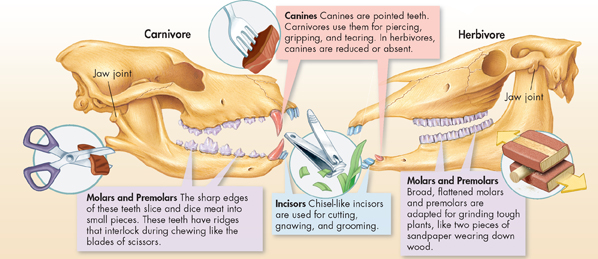One-way digestive tracts often have specialized structures, such as a stomach and intestines, that perform different tasks as food passes through them. You can think of a digestive tract as a kind of “disassembly line” that breaks down food one step at a time. In some animals, the mouth secretes digestive enzymes that start the chemical digestion of food. Then, mechanical digestion may occur as specialized mouthparts or a muscular organ called a gizzard breaks food into small pieces. Then, chemical digestion begins or continues in a stomach that secretes digestive enzymes. Chemical breakdown continues in the intestines, sometimes aided by secretions from other organs such as a liver or pancreas. Intestines also absorb the nutrients released by digestion.
▸ Solid Waste Disposal No matter how efficiently an animal breaks down food and extracts nutrients, some indigestible material will always be left. These solid wastes, or feces, are expelled either through the single digestive opening or through the anus.

FIGURE 27–2 Digesting Food Animals have different digestive structures with different functions. A The sponge (previous page) has one digestive opening and uses intracellular digestion to process its food. B The cnidarian (previous page) processes its food by extracellular digestion in a gastrovascular cavity. C The bird has a one-way digestive tract with two openings.
Specializations for Different Diets
 How are mouthparts adapted for different diets?
How are mouthparts adapted for different diets?
The mouthparts and digestive systems of animals have evolved many adaptations to the physical and chemical characteristics of different foods, as shown in Figure 27–3. As a window into these specializations, we'll examine adaptations to two food types that are very different physically and chemically: meat and plant leaves.
Specialized Mouthparts Carnivores and leaf-eating herbivores usually have very different mouthparts. These differences are typically related to the different physical characteristics of meat and plant leaves.
VISUAL ANALOGY
SPECIALIZED TEETH

Table of Contents
- Formulas and Equations
- Applying Formulas and Equations
- Mean, Median, and Mode
- Estimation
- Using Measurements in Calculations
- Effects of Measurement Errors
- Accuracy
- Precision
- Comparing Accuracy and Precision
- Significant Figures
- Calculating With Significant Figures
- Scientific Notation
- Calculating With Scientific Notation
- Dimensional Analysis
- Applying Dimensional Analysis





